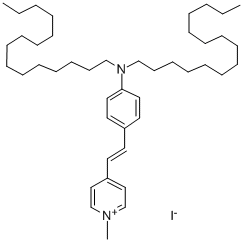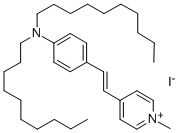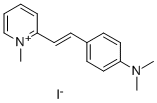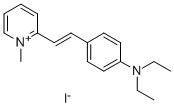4-DI-2-ASP
Synonym(s):4-Di-2-ASP
- CAS NO.:105802-46-8
- Empirical Formula: C18H23IN2
- Molecular Weight: 394.29
- MDL number: MFCD00031908
- SAFETY DATA SHEET (SDS)
- Update Date: 2024-10-28 16:48:35

What is 4-DI-2-ASP?
The Uses of 4-DI-2-ASP
Some cationic mitochondrial dyes such as 4-Di-1-ASP and 4-Di-2-ASP stain presynaptic nerve terminals independent of neuronal activity.
The Uses of 4-DI-2-ASP
Reactant or reagent involved in:• ;Two-photon absorption of organic / polyoxometalate hybrid dyes1• ;Acting as an acceptor for the 1D light-harvesting antenna2• ;Functional live cell fluorescence imaging for pulmonary neuroepithelial body microenvironments3• ;Studies of solvatochromism and dipole moments of monochromophoric styrylpyridinium dyes4
The Uses of 4-DI-2-ASP
Fluorescent cationic styryl probe for mitochondrial staining
What are the applications of Application
4-(4-Diethylaminostyryl)-1-methylpyridinium iodide is a probe for mitochondrial staining
Definition
ChEBI: An organic iodide salt consisting of pyridinium iodide having a methyl substituent at the 1-position and a 4-diethylaminostyryl substituent at the 4-position.
Properties of 4-DI-2-ASP
| Melting point: | 214-216 °C(lit.) |
| storage temp. | Amber Vial, -20°C Freezer, Under inert atmosphere |
| solubility | DMF: soluble |
| form | Solid |
| color | Red solid |
| λmax | 488 nm (MeOH); 484.7 nm
(DMSO); 471 nm (H2O) |
| BRN | 6101936 |
| Major Application | Bentonite clay;characterizing supramolecular materials; visualizingmesopores and defects in porous molecular sieves;nonlinear optical devices/materials; photographicmaterials/systems;photoresists |
| Biological Applications | Assessing nerveultrastructure; characterizing Merkel cells andmechanosensory axons; diagnosing of Hirschsprung’sdisease; identifying neuroepithelial bodies (NEBs);investigating stability and release properties ofbiodegradable polylactic acid (PLA) particles;measuring blood cells (erythrocytes, reticulocytes, bloodplatelets);visualizing nerve terminals and myelinatedfibers |
Safety information for 4-DI-2-ASP
| Signal word | Warning |
| Pictogram(s) |
 Exclamation Mark Irritant GHS07 |
| GHS Hazard Statements |
H315:Skin corrosion/irritation H319:Serious eye damage/eye irritation H335:Specific target organ toxicity, single exposure;Respiratory tract irritation |
| Precautionary Statement Codes |
P261:Avoid breathing dust/fume/gas/mist/vapours/spray. P264:Wash hands thoroughly after handling. P264:Wash skin thouroughly after handling. P271:Use only outdoors or in a well-ventilated area. P280:Wear protective gloves/protective clothing/eye protection/face protection. P302+P352:IF ON SKIN: wash with plenty of soap and water. P305+P351+P338:IF IN EYES: Rinse cautiously with water for several minutes. Remove contact lenses, if present and easy to do. Continuerinsing. |
Computed Descriptors for 4-DI-2-ASP
New Products
Tert-butyl bis(2-chloroethyl)carbamate (S)-3-Aminobutanenitrile hydrochloride N-Boc-D-alaninol N-BOC-D/L-ALANINOL 3-(2,4-Dimethoxybenzyl)dihydropyrimidine-2,4(1H,3H)-dione 7-Bromo-1H-indazole N-octanoyl benzotriazole 3,4-Dibenzyloxybenzaldehyde 4-Hydrazinobenzoic acid Electrolytic Iron Powder Fmoc-Val-Cit-PAB 1,1’-CARBONYLDIIMIDAZOLE R-2-BENZYLOXY PROPIONIC ACID 4-HYDROXY BENZYL ALCOHOL 1,1’-CARBONYLDI (1,2-4 TRIAZOLE) S-2-CHLORO PROPIONIC ACID (2-Hydroxyphenyl)acetonitrile 4-Bromopyrazole 5-BROMO-2CYANO PYRIDINE 5,6-Dimethoxyindanone 5-broMo-2-chloro-N-cyclopentylpyriMidin-4-aMine 1-(4-Methylphenylsulfonyl)-1H-1,2,3-benzotriazole 1-(2-Chlorobenzyl)-4-nitro-1H-pyrazole 1-(2-Nitrophenyl)-4-phenylpiperazineRelated products of tetrahydrofuran








You may like
-
 4-(4-Diethylaminostyryl)-1-methylpyridinium iodide CAS 105802-46-8View Details
4-(4-Diethylaminostyryl)-1-methylpyridinium iodide CAS 105802-46-8View Details
105802-46-8 -
 55441-95-7 2 2-BIS(2-HYDROXYETHOXY)-1 1-BINAPHTHYL 99%View Details
55441-95-7 2 2-BIS(2-HYDROXYETHOXY)-1 1-BINAPHTHYL 99%View Details
55441-95-7 -
 Ste-Glu-AEEA-AEEA-OSUView Details
Ste-Glu-AEEA-AEEA-OSUView Details
1169630-40-3 -
 1446013-08-6 Fmoc-His-Aib-OH TFA 98%View Details
1446013-08-6 Fmoc-His-Aib-OH TFA 98%View Details
1446013-08-6 -
 127464-43-1 99%View Details
127464-43-1 99%View Details
127464-43-1 -
 Chloro Uracil 99%View Details
Chloro Uracil 99%View Details
1820-81-1 -
 2-ETHYLPYRIDINE 100-71-0 99%View Details
2-ETHYLPYRIDINE 100-71-0 99%View Details
100-71-0 -
 13162-05-5 99%View Details
13162-05-5 99%View Details
13162-05-5